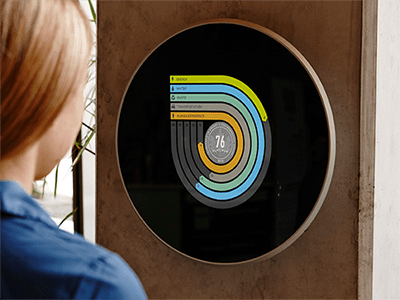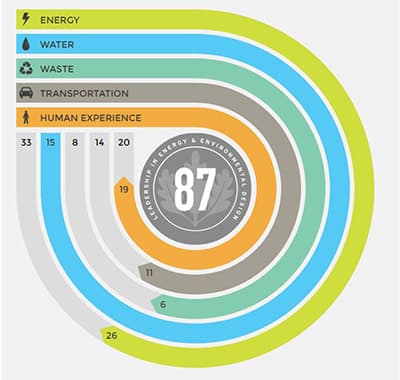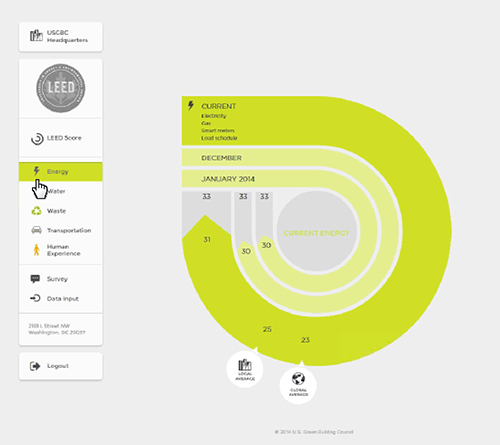Arc: The Wave of the Future for High Performance Buildings
How U.S. Green Building Council’s (USGBC’s) New Arc program Works
By Jenna Lipscomb
Cadmus gets a lot of questions about how the U.S. Green Building Council’s (USGBC’s) new Arc program works. We have worked in depth with the USGBC to fully understand the program intent and the specific differences between this program and EB O&M recertification. In short, Arc—formerly called Dynamic Plaque—is where the USGBC would like to eventually redirect market focus.
If you are familiar with ENERGY STAR® Portfolio Manager®, think of Arc as the LEED equivalent of that program. Building performance data is entered online on a monthly and annual basis, the LEED score will shift with each data update, and at the end of the year, the annual dataset is submitted to the USGBC for review. In essence, it is like recertifying every year.
Unlike the current LEED ratings systems, only performance-based data is entered into Arc. This includes utility bills, water bills, waste diversion reports, occupant survey data, occupant transportation data, waste audit data, and indoor air quality readings. There are no prescriptive tasks required, like commissioning or energy auditing: the USBGC is only interested in the resulting energy performance.
The intended path through this program is for the building to pursue one of the traditional LEED certification rating systems, then enter into the Arc program. For example, a new construction project might pursue LEED BD+C, then start the Arc program and begin tracking these performance metrics once the building has been operating for at least one year. Similarly, a building can pursue a LEED EB O&M certification, then enter the Arc program instead of following the recertification path. While originally intended only for LEED certified projects, Arc is now open to all buildings, regardless of certification status.
How it Works
There are five Arc categories (Energy, Water, Waste, Transportation and Human Experience) and one static category, which is based on the credits earned in the initial certification and is worth 10 total points.
As shown in Figure 1, each Arc category is worth varying points, with Energy being the most impactful category at 33 total points and Waste Management the least impactful at 8 points. Like the other rating systems, the score will be between 0 and 100 points, with the same thresholds for levels of certification as the other rating systems. Each category has essentially only one metric.
Energy and Water
For both the Energy and Water categories, you can either enter utility bills manually or just set up Arc to link directly to your ENERGY STAR® portfolio. Much like ENERGY STAR®, the utility data is compared to a dataset of buildings to determine how many of the total possible points the building’s performance earns (33 for Energy, 15 for Water). The graphic within each category will show how the current month’s data compares to the prior month and the prior year data (see Figure 2).
Waste
There are two metrics for the Waste category: the ongoing waste and recycling values, and the results of an annual waste audit. Again, the ongoing diversion data is compared to a dataset of buildings to evaluate the diversion rate as well as the total amount of waste material you are generating. A compliant waste audit needs to be conducted annually, with that report submitted for annual USGBC review.
Transportation
For the Transportation category, much like the LEED EB O&M rating system, a survey needs to be sent to all occupants annually to collect data on how they typically travel to the building. Arc has integrated this survey into its online platform, so you can provide occupants with a link and the data will be automatically collected and analyzed within the Arc platform, which is very handy.
Human Experience
There are a couple of different metrics for the Human Experience category. Again, much like the LEED EB O&M rating system, a survey must to be sent to all occupants annually to collect data on their satisfaction with the thermal environment. This is part of the same survey used for the Transportation category.
The other metric for this category is building-wide testing for Volatile Organic Compounds (VOC) and CO2 concentrations, which must be conducted at least once annually.
Both metrics are reported within the Arc platform, and a final report is required for the annual USGBC review. There are very specific requirements as to how many readings are needed, the timeframe between readings, and the equipment used to take the readings.
Base Score
The static category is the base score, which is derived from your initial certification. The base score is not shown on the graphic. There are specific credits and points for each rating system and version. The base credits for LEED EB O&M v2009 are outlined below:
- SSc2 Building Exterior and Hardscape Management (1 point)
- SSc3 Integrated Pest Management, Erosion Control, and Landscape Management (1 point)
- SSc5 Site Development—Protect and Restore Open Space (1 point)
- SSc6 Stormwater Quantity Control (1 point)
- SSc7.1 Heat Island Reduction—Non Roof (1 point)
- SSc7.2 Heat Island Reduction—Roof (1 point)
- SSc8 Light Pollution Reduction (1 point)
- EAc5 Enhanced Refrigerant Management (1 point)
- EQc3.6 Green Cleaning—Indoor Integrated Pest Management (1 point)
- EQc2.2 Controllability of Systems—Lighting (1 point)
- EQc2.3 Occupant Comfort—Thermal Comfort Monitoring (1 point)
- EQc2.4 Daylight and Views (1 point)
If the building earned any of these credits in the initial LEED EB O&M certification, it earns one point in Arc for each, up to a maximum of 10 points. If the building did not earn some of these credits, but you would like to achieve them to increase the base score, you can submit documentation at any point to demonstrate that you are currently meeting the requirements of the base credit. Much like a Credit Interpretation Ruling (CIR) (in process and cost), you can submit all of the required documentation and credit from the EB O&M rating system for USGBC review. For example, if you did not attempt SSc8 in the original certification because the building’s exterior lighting configuration was not compliant, but you have redesigned it to be compliant in the interim, you can submit documentation for that individual credit to confirm compliance. Note that this isn’t currently an automated feature in the platforms for already certified projects, but likely will be in the future.
For non-certified projects, the project will need to submit all prerequisite documentation applicable to their project type (NC, EB, etc), and can submit any base credit documentation for USGBC review within the Arc platform. This extra step for non-certified buildings ensure all buildings that become certified under Arc meet the same prerequisites for the program, whether the project used LEED online or Arc. For single-building non-certified projects, at this time Cadmus recommends going through the traditional LEED program to earn certification rather than using the Arc program right away. There are significant benefits to developing standardized documentation for many of the LEED strategies, which are largely bypassed in the Arc platform. Exceptions might include large groupings or portfolios of buildings where the relative ease of scalability of Arc is an asset.
Costs
In the past, this program was subscription based, requiring annual payment for access to the platform. However, with the change from Dynamic Plaque to Arc, the subscription format was replaced by a certification cost—similar to LEED EB—built on a five-year time horizon. The full certification cost is due at the time of the first submittal for USGBC review. The certification cost buys you access to the platform functionality to provide a dynamic score, as well as an annual USGBC review for the five-year duration. Recertification costs vary based on the size of the building, and the pricing structure was updated by the USGBC on December 1, 2016.
While the Dynamic Plaque name has been retired, Arc retains the physical plaque that formed its predecessor’s centerpiece. The plaque itself is an interactive display showing the current score and allowing occupants, guests, or any other passersby a view of the metrics behind the score. This plaque is an optional purchase of $6,000, and the platform is accessible without purchasing the plaque, much like ENERGY STAR® Portfolio Manager.

Depending on your comfort level with this material and your access to equipment, both options will likely require some assistance from consultants, adding associated services and fees. The recertification option requires more documentation and significant time dedicated to the effort once every five years, but little effort between recertifications. The Arc certification option advocates monthly or quarterly check-ins with some annual efforts, but overall requires significantly less documentation. Based on Cadmus’ assessment, the building team will spend equal or less time to maintain Arc over a five-year period compared to a recertification. Similarly, if you engage consultants, they will spend time on the site annually in several performance areas for Arc certification, rather than conducting a large on-site documentation effort every five years; Cadmus has assessed that consulting fees for both options will end up being roughly equal over the five-year duration.
Benefits of Arc Over Recreation
- There is a more even and predictable internal time commitment and consultant costs because these items occur each year rather than being consolidated once every five years.
- The score is primarily performance based, so increased performance translates quickly to an increased score (of course, the opposite is true as well!).
- It is easier to enter data into the online platform, much like ENERGY STAR® Portfolio Manager, which most building teams are already familiar with.
- This program represents the direction the USGBC would like to take recertification efforts, so early adoption will likely be beneficial.
- Only performance data is needed, and you no longer need to provide documents for several documentation-heavy credits already earned in the initial LEED EB O&M certification.
- The base credits are from the certification that was already earned, so there is no need to relearn each new version of the EB O&M rating system (such as v4).
- You will receive more regular attention from your consultant to discuss your current and goal sustainability efforts.
Benefits of Recertification Over Arc
- It does not require an annual effort, which helps when budgets are variable or if the team loses track of this effort.
- Falling short of the base credits will not hurt you, as they would under Arc. If your base credits are less than you desired, you may want to pursue another recertification and target those credits before pursuing Arc.
- The base credits are largely static and based on the version of the EB O&M rating system used. To earn more base credits, you will need to submit individual credit documentation, likely at CIR prices. If you want to apply a newer rating system, Cadmus recommends pursuing an EB O&M recertification in the newer rating system instead of submitting all 10 base credits individually through Arc.
- The certification earned is easily recognized, while the certification within Arc just becomes a “LEED certification,” no longer a “LEED EB O&M certification.” It is unclear how this will be recognized by various states and cities that have legislation referencing specific rating systems; however, this will likely be resolved once governments become more familiar with this new program.
- The certification will show up in the LEED Project Directory, unlike LEED certifications earned through Arc. Recertified projects are, therefore, currently easier for the public to verify than Arc projects (though this will also likely be resolved in time).
If your buildings already have a certification, you can activate your existing LEED certified project within Arc to figure out what score your building might currently receive before you commit to it completely. Note that you should activate your most recently certified project, not your registered-but-uncertified projects (in the case of registrations prepared for future recertification). Any projects that do not currently have a certification can create a new project in Arc by registering a new project and paying the registration fee.
Cadmus is excited about Arc, which feels like a natural extension of all the rating systems, and is focused on performance and optimization over time rather than the documentation of static strategies. Feel free to visit the Arc website for more information. Contact us today to discuss the specifics of your project and how it might best fit into this platform.

